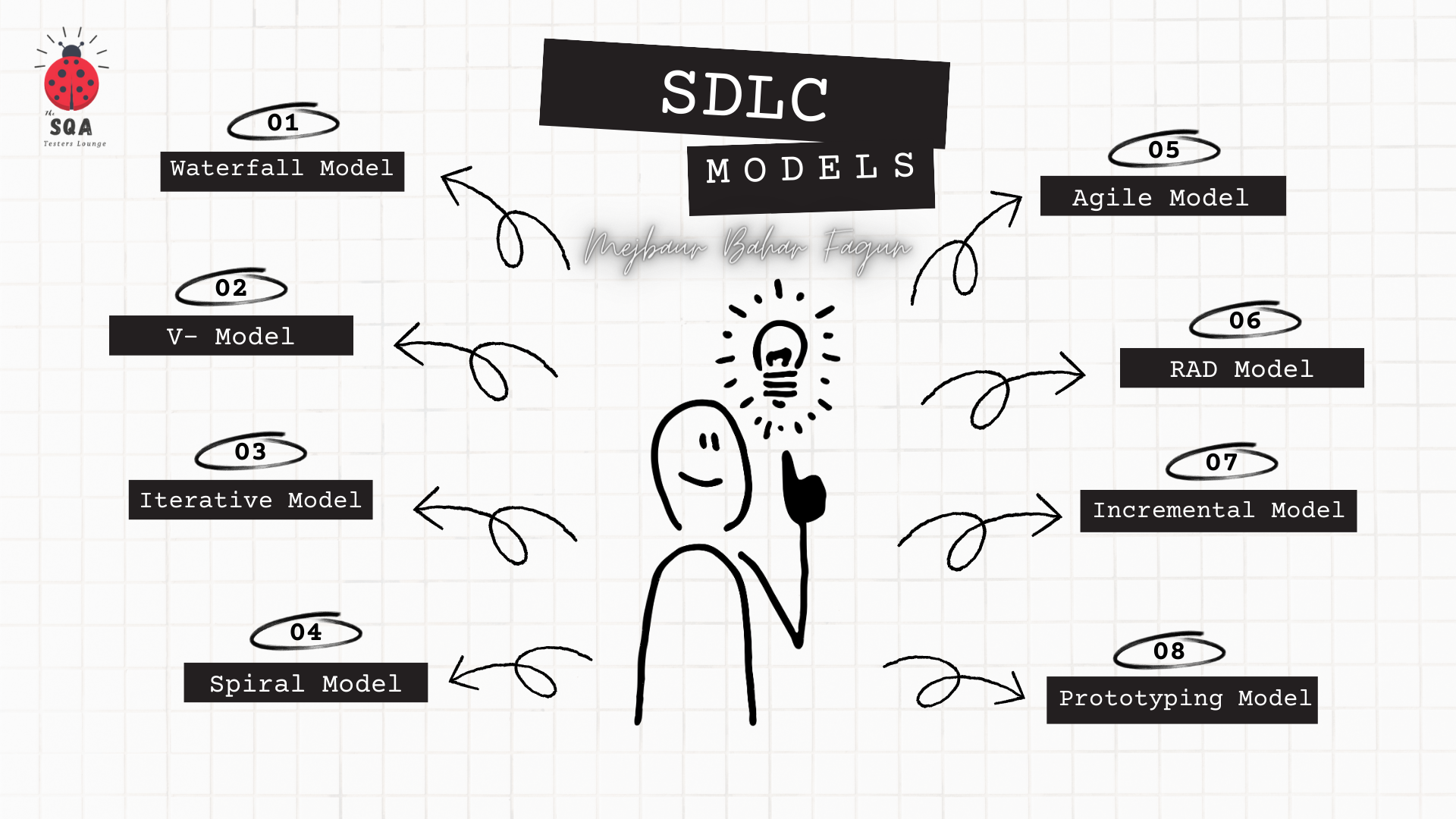Choosing the Right Software Development Life Cycle Model: A Comprehensive Guide to Understanding and Selecting the Best Model for Your Project
 Mejbaur Bahar Fagun
Mejbaur Bahar Fagun
Software Development Life Cycle (SDLC) models are a series of stages that guide the development of software systems. These models provide a systematic approach to software development, ensuring that the process is efficient and effective and produces high-quality software. There are several different SDLC models, each with its strengths and weaknesses. In this article, we will discuss the various SDLC models in detail.
Choosing the right software development life cycle model is like choosing the right tool for the job - it can make all the difference in the success of your project.
- Waterfall Model: The waterfall model is the most traditional and widely used SDLC model. It is a linear, sequential approach to software development, where each phase must be completed before the next can begin. The waterfall model comprises five phases: requirements gathering and analysis, design, implementation, testing, and maintenance. This model is best suited for projects where the requirements are well-defined and there is little chance of changes.
The requirements gathering and analysis phase involves understanding the customer's needs and requirements. This phase involves gathering all the necessary information to understand the scope of the project. The design phase involves creating a blueprint for the software system. The implementation phase involves coding the software based on the design. The testing phase involves testing the software to ensure that it meets the requirements. The maintenance phase involves maintaining the software and making necessary changes based on user feedback.
- V-Model: The V-Model is an extension of the waterfall model. This model adds testing to each phase of the development process, ensuring that the system is thoroughly tested before it is released. The V-model consists of the following phases: requirements gathering and analysis, design, implementation, testing, and maintenance.
The V-model emphasizes the importance of testing and quality assurance. The testing phase is an integral part of each stage, ensuring that each phase meets the requirements and is functioning properly. The V-model is best suited for projects where quality is a high priority.
- Iterative Model: The iterative model is an SDLC model that allows for continuous feedback and refinement throughout the development process. This model consists of a series of iterations, with each iteration producing a working prototype of the software system. The iterative model is ideal for projects where the requirements are not well-defined, as it allows for changes and adjustments to be made as the development process progresses.
The iterative model is a flexible model that allows for continuous feedback from the customer. Each iteration involves feedback and refinement, ensuring that the final product meets the customer's needs. The iterative model is best suited for projects where flexibility and adaptability are high priorities.
- Spiral Model: The spiral model is a combination of the iterative model and the waterfall model. It is an SDLC model that emphasizes risk analysis and mitigation. The spiral model consists of four phases: planning, risk analysis, engineering, and evaluation. The spiral model is ideal for projects that involve a high level of risk, as it allows for risk mitigation to be incorporated into the development process.
The spiral model involves continuous evaluation and improvement throughout the development process. Each phase involves risk analysis and mitigation, ensuring that the final product meets the customer's needs and is delivered on time and within budget. The spiral model is best suited for projects where risk management is a high priority.
- Agile Model: The agile model is a popular SDLC model that emphasizes collaboration, flexibility, and customer satisfaction. This model consists of a series of iterations, with each iteration producing a working prototype of the software system. The agile model is ideal for projects that require frequent changes and adjustments, as it allows for continuous feedback and refinement.
The agile model emphasizes the importance of collaboration and communication throughout the development process. Each iteration involves feedback and refinement, ensuring that the final product meets the customer's needs. The agile model is best suited for projects where flexibility and adaptability are high priorities.
- RAD Model: The RAD model is an SDLC model that emphasizes rapid prototyping and user feedback. This model consists of four phases: requirements planning, user design, construction, and cutover. The RAD model is ideal for projects where speed and user feedback are high priorities.
The RAD model involves rapid prototyping and development of the software system. The requirements planning phase involves understanding the customer's needs and requirements. The user design phase involves creating a prototype of the software system. The construction phase involves developing the software based on the prototype. The cutover phase involves delivering the final product to the customer.
- Incremental Model: The incremental model is an SDLC model that emphasizes the delivery of working software in small increments. This model consists of a series of iterations, with each iteration producing a working prototype of the software system. The incremental model is ideal for large projects where the requirements are not well-defined, as it allows for changes and adjustments to be made as the development process progresses.
The incremental model involves the continuous delivery of working software in small increments. Each increment involves feedback and refinement, ensuring that the final product meets the customer's needs. The incremental model is best suited for projects where flexibility and adaptability are high priorities.
- Prototyping Model: The prototyping model is an SDLC model that emphasizes the creation of prototypes of the software system. This model consists of a series of iterations, with each iteration producing a working prototype of the software system. The prototyping model is ideal for projects where the requirements are not well-defined, as it allows for changes and adjustments to be made as the development process progresses.
The prototyping model involves the creation of prototypes of the software system. Each prototype involves feedback and refinement, ensuring that the final product meets the customer's needs. The prototyping model is best suited for projects where flexibility and adaptability are high priorities.
📢 Join SQA Testers Facebook Group: https://lnkd.in/gQhm6pCY
In conclusion, there are various SDLC models that software development teams can adopt to achieve their desired goals. The choice of an SDLC model depends on the project's requirements, scope, and constraints. Each model has its strengths and weaknesses, and software development teams need to choose the model that best suits their needs. Regardless of the SDLC model chosen, the goal is to deliver a high-quality software system that meets the customer's needs and is delivered on time and within budget.
🔀 𝐂𝐨𝐧𝐧𝐞𝐜𝐭 𝐖𝐢𝐭𝐡 𝐌𝐞
𝐅𝐚𝐜𝐞𝐛𝐨𝐨𝐤: https://lnkd.in/dQhnGZTy
𝐅𝐚𝐜𝐞𝐛𝐨𝐨𝐤 𝐏𝐚𝐠𝐞: https://lnkd.in/gaSKMG2y
𝐈𝐧𝐬𝐭𝐚𝐠𝐫𝐚𝐦: https://lnkd.in/gid7Ehku
Twitter: Mejbaur Bahar Fagun (@fagun018) / Twitter
𝐌𝐞𝐝𝐢𝐮𝐦: https://lnkd.in/gP6V2iQz
𝐆𝐢𝐭𝐡𝐮𝐛: https://github.com/fagunti
𝐘𝐨𝐮𝐓𝐮𝐛𝐞: https://lnkd.in/gg9AY4BE
#SDLC #SoftwareDevelopment #WaterfallModel #VModel #IterativeModel #SpiralModel #AgileModel #RADModel #IncrementalModel #PrototypingModel #SoftwareEngineering #ProjectManagement #SoftwareDesign #SoftwareTesting #SoftwareDelivery #softwarequalityassurance #sdlc #sdlcmodels #worterfallmodel #sqatesterslounge #thesqatesterslounge #sqatesterlounge #thesqatesterlounge #mejbaurbaharfagun #SoftwareDevelopmentLifeCycle #SDLCModels #DevelopmentProcess #SoftwareProjectManagement #ProductDevelopment #SoftwareRequirements #SoftwarePrototype #SoftwareDeliveryCycle #SoftwareProductivity #SoftwareMaintenance #SoftwareLifecycle #SDLCMethodologies
Subscribe to my newsletter
Read articles from Mejbaur Bahar Fagun directly inside your inbox. Subscribe to the newsletter, and don't miss out.
Written by

Mejbaur Bahar Fagun
Mejbaur Bahar Fagun
With a strong background in both Software QA Engineering and Certified Ethical Hacking, I bring a unique and comprehensive skill set to my work. My expertise in manual and automated testing, along with my ability to design effective test frameworks from scratch, makes me a valuable asset to any software development team. My familiarity with both the Waterfall and Scrum methodologies of the SDLC ensure that I can operate seamlessly within any development process. I have a proven track record of effectively verifying software products, conducting thorough online form factor validations, and verifying complex algorithm designs through the use of Matlab scripts. Let me bring my technical expertise and commitment to ethical practices to your next project.